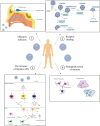Infection routes, invasion mechanisms, and drug inhibition pathways of human coronaviruses on the nervous system
- PMID: 37139519
- PMCID: PMC10150004
- DOI: 10.3389/fnins.2023.1169740
Infection routes, invasion mechanisms, and drug inhibition pathways of human coronaviruses on the nervous system
Abstract
So far, numerous studies have reported on how coronaviruses affect the human nervous system. However, these studies mainly focused on the impact of a single coronavirus on the nervous system, and failed to fully report the invasion mechanisms and the rules of symptoms of the seven human coronaviruses. This research can assist medical professionals in identifying the regularity of coronavirus invasion into the nervous system by examining the impacts of human coronaviruses on the nervous system. Meanwhile, the discovery also helps humans to prevent the damage to the human nervous system caused by the more novel coronavirus in advance, thus reducing the rate of disease transmission and fatality caused by such viruses. In addition to describing the structures, routes of infection, and symptomatic manifestations of human coronaviruses, this review also finds that the structures of human coronaviruses correlate with virulence, pathways of infection, and blocking mechanisms of drugs. This review can provide a theoretical basis for the research and development of related drugs, promote the prevention and treatment of coronavirus infectious diseases, and contribute to global epidemic prevention.
Keywords: central nervous system; coronavirus; drug; peripheral nervous system; prevention and treatment.
Copyright © 2023 Sha and Chen.
Conflict of interest statement
The authors declare that the research was conducted in the absence of any commercial or financial relationships that could be construed as a potential conflict of interest.
Figures


References
-
- Chen J., Huang X., Zhang Y., Qing Y., Li Y., Wen X., et al. (2016). Progress in studying the aminopeptidase N receptor for coronaviruses. Chin. J. Zoonoses. 32 89–94.
Publication types
LinkOut - more resources
Full Text Sources

